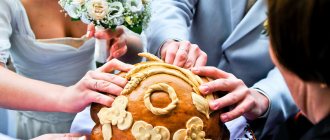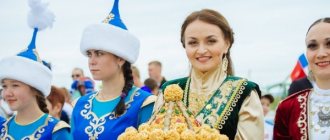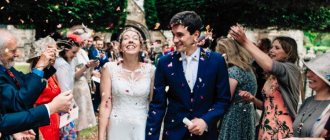Wedding rites and traditions among the ancient Slavs
A wedding ceremony is, to some extent, a mystical act, because just yesterday, complete strangers and strangers to each other, after a certain ceremony, suddenly become one family, a single whole.
Like most historical facts, we first learn about the life of the ancient Slavs from the Tale of Bygone Years. Nestor the chronicler wrote that it was during the wedding ceremony that the moral essence of a particular people is revealed.
The Polyans were considered peaceful people who revered the wedding ceremony as sacred, and peaceful life and mutual understanding in the family as an indispensable condition for future life together. Weddings at that time were not celebrated the way we celebrate them now. The bride was simply brought to the house of her future groom.
The Drevlyans did not have any specific moral principles, so it was customary among these people to steal brides. It’s just difficult to say whether this was a spontaneous decision or whether there were some specific agreements between the future husband and wife.
The Vyatichi, Northerners and Radimichi, as a rule, lived in forests. They usually did not enter into any marriages, but they organized special performances and games, at which representatives of several settlements (men) kidnapped future wives for themselves. It is also possible that the couples agreed in advance about who would be with whom. In addition, polygamy was accepted among these peoples.
Basically, all pagan wedding traditions and wedding rituals can be divided into two types:
- “leading” the wives, when the dowry was carried after the groom and the bride herself, which is somewhat reminiscent of a traditional Slavic marriage;
- "kidnapping" the bride, a crude option, of course, but it is still popular among many peoples even today.
With the development of society, the Slavic wedding ceremony also developed and expanded with new traditions. After a certain period of time, it acquired a certain meaning and order. Also, new deities began to appear, and the most cheerful and kind of them was Lado - the god of prosperity and love. The Slavs worshiped him and marriages were most often concluded on his day. Today, such a day can be considered Valentine's Day, when all couples strive to get married on this date.
Marriage in Rus' during Christianity
Kievan Rus adopted Christianity at the end of the 9th century in 988. New Christian wedding traditions entered the life of the common people with great difficulty. One of the most important innovations is the coverage of marriage in the church. True, it was not possible to completely instill this tradition in the Slavs of the Orthodox Church, and therefore this rule was not mandatory, and each nation continued to celebrate the wedding as best it could.
Many wedding customs and traditions were borrowed from other nations. So, for example, from Greece we borrowed the ritual of exchanging rings, as well as a veil (veil) on the bride’s head, wreaths, wedding candles, and at the end the ritual of joining the hands of the newlyweds.
It was customary to shower the ancient bride and groom with grain, money and hops, and our Russian loaf is just a reworked ancient Roman tradition.
Interesting fact: love and wedding did not intersect with each other. According to sociologists, marriage for love and mutual consent became possible only at the beginning of the 20th century, when women received some rights. In ancient times, a wedding was held not by a young man and a young girl, but by their families, who wanted to become related for mutual benefit. This was the custom among both the peasants and the nobility.
The time for a wedding directly depended on work in the field or on the farm, and in addition to this, there were also church prohibitions. For example, during Lent it was forbidden to get married, also on the eve of great Christian holidays, during Maslenitsa and Easter week, on the eve of Friday or Wednesday, and, of course, in May, since it was even believed among the people that those who marry in May, he will “toil all his life.”
Girls had to get married at the age of 12-13, but by this time they were fully trained housewives and knew all wedding customs. Even some dowry had already been saved up for the wedding. The most important thing for a young bride is to be able to embroider a gift with her own hands for her future husband, all the guests and his family.
Ancient Russian folk wedding rites and traditions
The newlyweds first met each other during their own wedding. Very rarely they were lucky, so it is no coincidence that Slavic women had so many “cries”. Folk wedding rituals and traditions among the Slavs consisted of several stages:
- Matchmaking;
- Bride"
- Hand-shaking (collusion) - determining and setting the date of the wedding ceremony, calculating expenses, etc.;
- Howling is the cry of a young bride in her parents’ house about the future separation and upcoming changes. At this stage the mother was undoing her daughter's braid;
- Bachelorette party - the bride still continues to cry, her girlfriends help her finish the gift for the groom and his family, and after that the girl is washed in the bathhouse;
- Bride ransom;
- Wedding;
- Wedding feast.
In Ancient Rus', each wedding stage corresponded to a number of traditions that were performed by certain people. So, for example, the matchmaker had to remove the girl’s wreath from the bride, twist her hair and put a kika (women’s headdress) on her head. On top of which they also put a blanket. When a father gave his daughter to her husband, he would lightly beat her with a whip so that her husband would obey, and then pass the whip to her future husband.
The wedding feast was a test not only for the guests and their stomachs, but also for the newlyweds themselves. It lasted, as a rule, three whole days. There was no place at the table for the newlyweds, so they first accepted congratulations from all their relatives, and then went to a wedding bed specially arranged for them in a hay barn with amulets and symbols.
On the second day of the wedding, the newlyweds were already seated at the table, and after the feast they were taken to the bathhouse, the matchmaker showed everyone the bride’s shirt, which was supposed to have blood on it as confirmation of her innocence. On the third day of the wedding, the young newly-made wife demonstrated her household skills to everyone, and the guests only occasionally helped her.
Wedding ceremonies and traditions of Russia today
A modern wedding combines not only the traditions of the Slavs, but also modern rituals associated with the realities and possibilities of our time, as well as colorful wedding rituals of other countries. Traditional moments of a modern Russian wedding:
- Matchmaking;
- Bride ransom;
- Registration of marriage at the registry office;
- Wedding in a church (at the request of the newlyweds);
- A trip or walk through the colorful places of the city with a photographer;
- A wedding banquet containing some traditions (removing the veil and putting a scarf on the head, dancing of the young wife and unmarried girls, throwing the wedding bouquet, etc.).
The bride price is of particular importance, since it is this tradition that basically sets the rhythm for the entire holiday, since it should be interesting, fun and memorable. Depending on the imagination of the organizer, it is held in a variety of styles: romantic, pirate, fairy tale, etc.
A wedding is one of the events in our lives that forever remains in the memory of the young, but traditions in ancient times were aimed at protecting the future family from various troubles and the evil eye.
How to write a term paper on speech therapy
07.09.2010 224986
These guidelines are compiled to help students gain an understanding of the content and structure of coursework in speech therapy.
Logopedia of pedagogical science that studies anomalies of speech development with normal hearing, explores the manifestations, nature and mechanisms of speech disorders, develops the scientific basis for overcoming and preventing them means of special training and education.
The subject of speech therapy as a science is speech disorders and the process of training and education of persons with speech disorders.
The object of study is a person suffering from a speech disorder.
The main task of speech therapy as a science is the study, prevention and elimination of various types of speech disorders.
Coursework in speech therapy is a student's scientific and experimental research. This type of educational activity, provided for by the educational and professional program and curriculum, contributes to the acquisition of skills in working with literature, analyzing and summarizing literary sources in order to determine the range of insufficiently studied problems, determining the content and methods of experimental research, processing skills and qualitative analysis of the results obtained. The need to complete coursework in speech therapy is due to the updating of knowledge concerning the content, organization, principles, methods and techniques of speech therapy work.
As a rule, during their studies, students must write two term papers - theoretical and practical.
The first course work should be devoted to the analysis and synthesis of general and specialized literature on the chosen topic. Based on this analysis, it is necessary to justify and develop a method of ascertaining (diagnostic) experiment.
In the second course work, it is necessary to provide an analysis of the results obtained during the ascertaining experiment, as well as determine the directions and content of speech therapy work, and select adequate methods and techniques of correction.
So, let’s present the general requirements for the content and design of coursework in speech therapy.
The initial and most important stage of working on a course project is the choice of a topic, which is either proposed by the supervisor or chosen by the student independently from a list of topics that are consistent with the areas of scientific research of the department.
Each topic can be modified, considered in different aspects, but taking into account a theoretical and practical approach. Having chosen a topic, the student needs to think through in detail its specific content, areas of work, practical material, etc., which should be reflected both in the formulation of the topic and in the further construction of the study. It should be recalled that the chosen topic may not only have a purely theoretical orientation, for example: “Dysarthria. Characteristics of the defect”, “Classification of dysgraphia”, but also take into account the practical significance of the problem under consideration, for example: “Speech therapy work on speech correction for dysarthria”. It should also be taken into account that when formulating a topic, excessive detail should be avoided, for example: “Formation of prosodic components of speech in preschoolers of the sixth year of life attending a preschool institution for children with severe speech impairments.”
The course work includes such mandatory parts as: introduction, three chapters, conclusion, bibliography and appendix.
The text of the term paper begins with the title page . An example of its design can be seen here.
Then the content of the work is given, in which the names of chapters, paragraphs, and sections are formulated in strict accordance with the content of the thesis. An example of its design can be seen here.
In the text, each subsequent chapter and paragraph begins on a new page. At the end of each chapter, the materials are summarized and conclusions are formulated.
The introduction reveals the relevance of the problem under consideration in general and the topic being studied in particular; the problem, subject, object, and purpose of the study are defined. In accordance with the goal and hypothesis, objectives and a set of research methods aimed at achieving the objectives must be defined.
The relevance of the topic lies in reflecting the current level of pedagogical science and practice, meeting the requirements of novelty and usefulness.
When defining the research problem, it is important to indicate what practical tasks it will help to implement in training and educating people with speech pathology.
The object of research is understood as certain aspects of pedagogical reality, perceived through a system of theoretical and practical knowledge. The ultimate goal of any research is to improve this object.
The subject of research is some part, property, element of an object, i.e. the subject of research always indicates a specific aspect of the object that is to be studied and about which the researcher wants to gain new knowledge. An object is a part of an object.
You can give an example of the formulation of the object, subject and problem of research:
– The object of the study is the speech activity of preschool children with phonetic-phonemic speech disorders.
– The subject of the study is the features of intonation speech of children with phonetic-phonemic speech disorders.
– The research problem is to determine effective directions for speech therapy work on the formation of intonation expressiveness of speech in the system of correctional intervention.
The purpose of the study contributes to the specification of the object being studied. The goal of any research is to solve a specific problem. The goal is specified in tasks taking into account the subject of research.
The research objectives are formulated in a certain sequence, which determines the logic of the research. The research objectives are set on the basis of a theoretical analysis of the problem and an assessment of the state of its solution in practice.
The first chapter is an analysis of literary sources, which examines the state of this problem in historical and modern aspects, and presents the most important theoretical principles that formed the basis of the study.
When writing the first chapter, you should pay attention to the fact that the text of the course work must be written in a scientific style. When presenting scientific material, it is necessary to comply with the following requirements:
– Specificity – a review of only those sources that are necessary to disclose only a given topic or solve only a given problem;
– Clarity – which is characterized by semantic coherence and integrity of individual parts of the text;
– Logicality – which provides for a certain structure of presentation of the material;
– Reasoning – evidence of thoughts (why this and not otherwise);
– Precision of wording, excluding ambiguous interpretation of the authors’ statements.
A literary review of the state of the problem being studied should not be reduced to a consistent presentation of literary sources. It should present a generalized description of the literature: highlight the main directions (currents, concepts, points of view), analyze in detail and evaluate the most fundamental works of representatives of these directions.
When writing a work, the student must correctly use literary materials, make references to the authors and sources from which the results of scientific research are borrowed. Failure to provide required references will reduce your coursework grade.
As a rule, in coursework on speech therapy, references to literary sources are formatted as follows: the number of the cited source in the general list of references is placed in square brackets. For example: General speech underdevelopment is a speech pathology in which there is a persistent lag in the formation of all components of the language system: phonetics, vocabulary and grammar [17].
When using quotations, in square brackets, in addition to indicating the source number, the page number from which this excerpt is taken is indicated, for example: Speech rhythm is based on a physiological and intellectual basis, since, firstly, it is directly related to the rhythm of breathing. Secondly, being an element that performs a communicative function, “correlates with meaning, i.e. controlled intellectually” [23, P.40].
However, course work should not be of a purely abstract nature, so you should not abuse the unreasonable abundance of citations. Quoting should be logically justified, convincing and used only when really necessary.
In the second chapter , devoted to experimental research, the organization should be described and the program of the ascertaining experiment should be presented. The survey methodology, as a rule, consists of a description of several series of tasks, with detailed instructions, visual and lexical material, the procedure for completing tasks by experiment participants, and scoring criteria. This chapter also provides a qualitative and quantitative analysis of the results obtained.
When analyzing the results of an experiment, it is necessary to use a scoring system. Examples of various criteria for quantitative and qualitative assessment are presented in the following works:
– Glukhov V.P. Formation of coherent speech in preschool children with general speech underdevelopment. - M.: Arkti, 2002. - 144 p.
– Fotekova T.A. Test methodology for diagnosing oral speech of primary schoolchildren. - M.: Arkti, 2000. - 56 p.
– Levchenko I.Yu. Pathopsychology: Theory and practice. - M.: Academy, 2000. - 232 p.
In order to visually present the results obtained during the experimental study, it is recommended to use tables, graphs, diagrams, etc. Histograms can be used in a variety of ways - columnar, cylindrical, planar, volumetric, etc. An example of the design of tables, figures, and histograms can be found here.
The third chapter provides a rationale for the proposed methods and techniques and reveals the content of the main stages of correctional work.
The conclusion contains a summary of the material presented and the main conclusions formulated by the author.
The bibliography must contain at least 25 sources. The list includes bibliographic information about the sources used in preparing the work. An example of its design can be seen here.
In the application you can present bulky tables or illustrations, examination protocols, observation records, products of activity (drawings, written works of children), notes from speech therapy classes, etc.
The volume of one course work must be at least 30 pages of typewritten text.
In general, coursework in speech therapy is the basis for a future thesis, in which the study of the begun problem can be continued, but from the standpoint of a different approach or a comparative analysis of the disorders being studied in different age categories of people with different types of speech disorders.
The content and format of theses in speech therapy can be found here.
Literature:
1. How to write a term paper on speech therapy: Methodological recommendations. Educational and methodological manual / Comp. Artemova E.E., Tishina L.A. / Ed. Orlova O.S. – M.: MGOPU, 2008. – 35 p.
2. Research work of students in the system of higher professional pedagogical education (specialty 031800 - Speech therapy). Methodological recommendations for completing the thesis / Compiled by. L.V. Lopatina, V.I. Lipakova, G.G. Golubeva. - St. Petersburg: Publishing house of the Russian State Pedagogical University named after. A. I. Herzen, 2002. - 140 p.
Virginity: truth and myths
But chastity was not always a prerequisite. Before the baptism of Rus', an illegitimate child of a bride was generally considered a kind of “bonus”: it means she is healthy and will be able to give birth to children for her husband.
With the advent of Christianity, attitudes towards this issue changed. It was believed that the bride should be a virgin. But it cannot be said that this rule was too strict, especially in the outback. Tricky jokes about the hayloft were not invented by modern youth, right? But the reputation of a walking person who dated many men definitely put an end to dreams of family life.
The attitude towards widows was ambiguous. Of course, no one considered a woman who was already married to be a virgin, but she could hardly be considered one of the leading brides. If there was a good dowry, a widow could be married to a prominent groom. But usually, if such a woman remarried, it was to a widower, a disabled soldier, or an older man.
The potential for a malicious attack is very high: a vulnerability has been found in Windows antivirus
Shoes for training: going to try them on in the evening and more tips on choosing
An unusual 25 meter high panoramic hill will appear in the center of London
In a healthy body
In film adaptations of fairy tales and historical novels, we often see fragile beauties. This has nothing to do with how the ideal bride was imagined in Rus'.
The skinny girl had every chance of staying with the girls. Firstly, excessive thinness was considered a sign of illness, such as consumption.
Secondly, with the level of development of medicine in general and obstetrics in particular, there was a high risk of dying in childbirth or giving birth to a stillborn child.
Thirdly, no matter how banal it may sound, in Rus' girls not only spun under the window and embroidered towels, but also worked. For a representative of the working class, her graceful build was a real downfall. A thin girl was perceived as a bad, weak worker who would be of no use on the farm. And one should not think that this did not concern the daughters of the deliberate boyars: a huge number of responsibilities also fell on the shoulders of a rich woman.
Be an inspiration and muse for your husband. The secret of Alferova's happy brother
Not at all. Statistics show what men want on February 23
“I don’t care anymore”: the biathlon world champion gave up in the middle of the race
Well, fourthly, the thin girl gave the impression of being underfed and poor. It was a shame for both the father and the husband.











